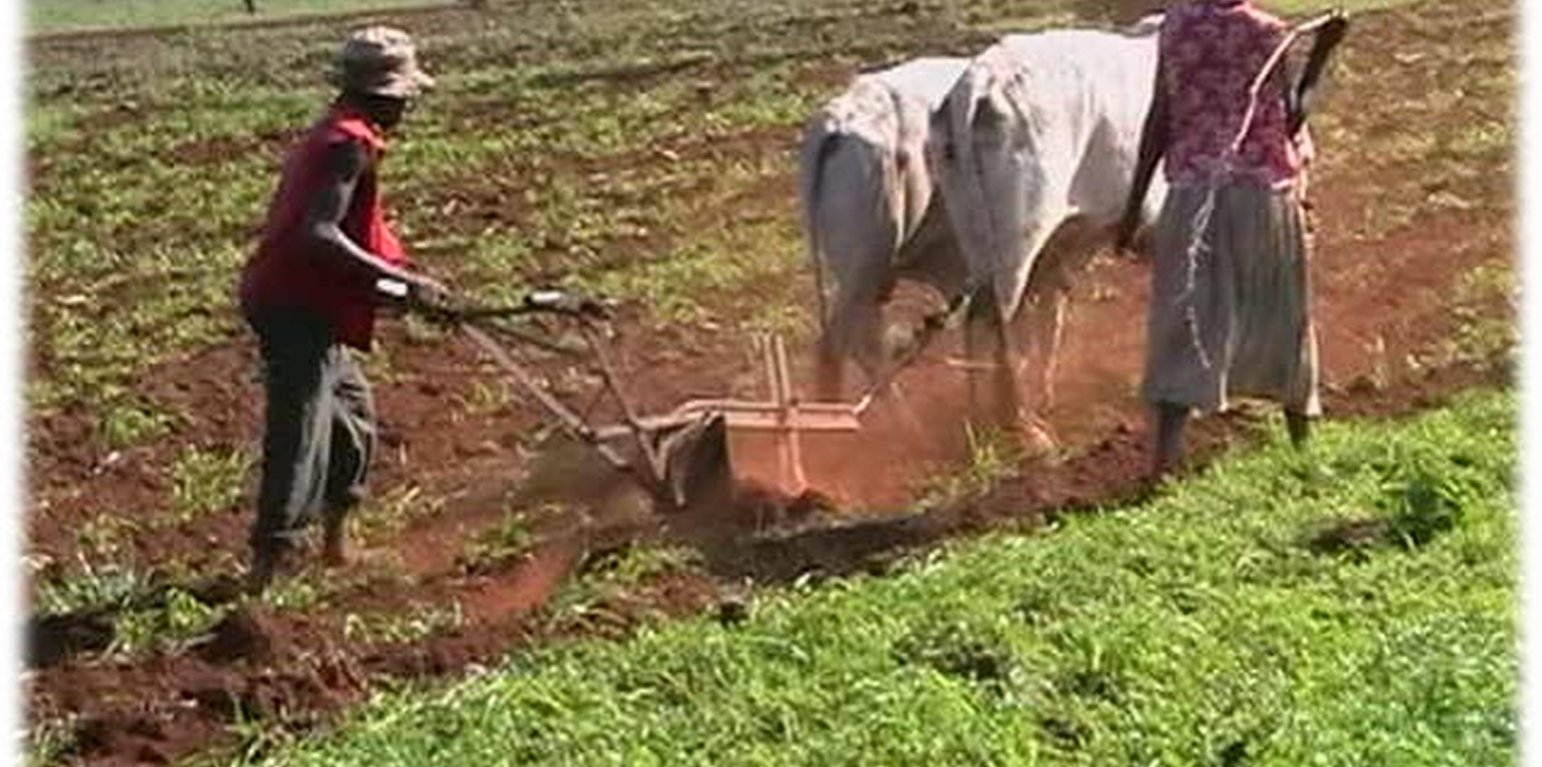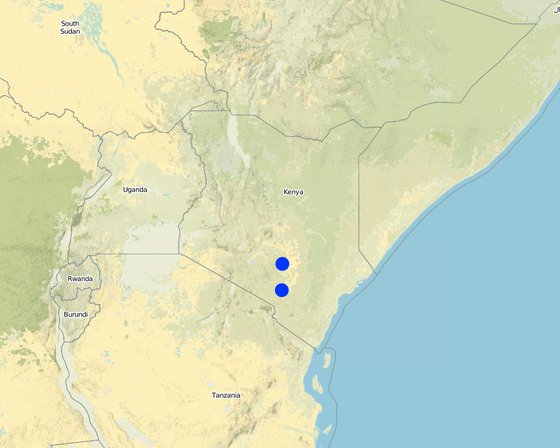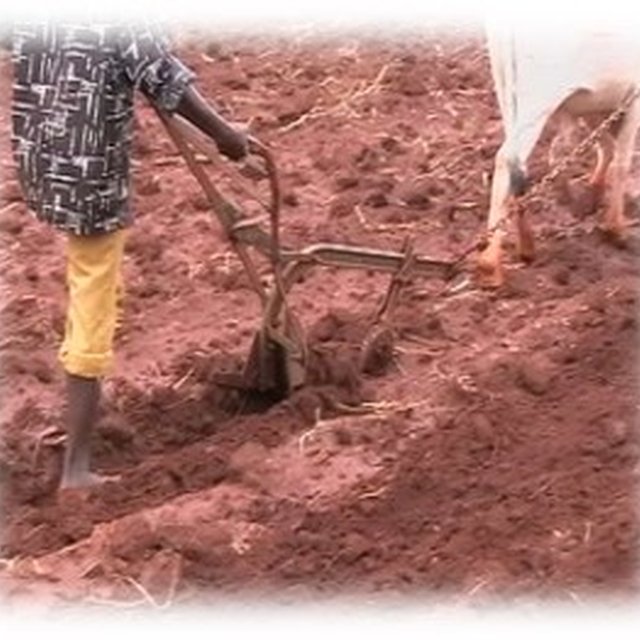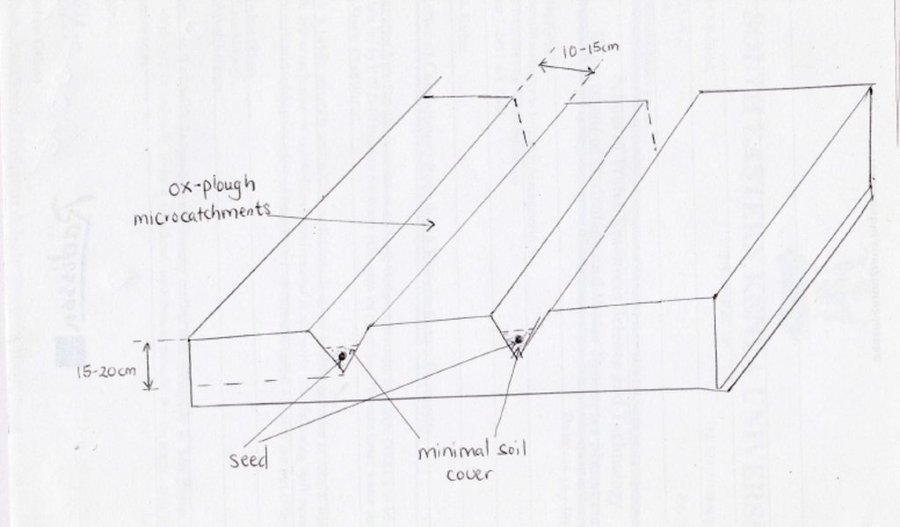



Creation of furrow micro-catchments using an ox-driven plough is a traditional seedbed preparation practice among agropastoral communities inhabiting arid and semi-arid environments in Kenya. The process involves minimal soil disturbance by intentionally creating shallow furrows (about 20 cm depth) using an ox-driven plough. Oxen commonly used predominantly have a light and bright skin coat. This is aimed at reflecting away excess heat from the sun. Consequently, the oxen are less fatigued and can therefore plough for a longer period of time. The furrow microcatchments are intentionally created across the slope to harvest rainwater to prolong water availability for seed germnination and subsequent growth and development of emerging seedlings. Furthermore, the ox-plough breaks the soil hard-pan common in dryland environments. Therefore, the microcatchments also facilitate seedling root penetration to the lower horizons. Prolonged water availability, especially in dryland environments, promotes growth and development of fast growing and early maturing drought tolerant crops and indigenous pasture production, consequently better crop yields and pasture production.

สถานที่: Kibwezi, Makueni County, Kenya, Kibwezi, Eastern Kenya, เคนยา
ตำนวนการวิเคราะห์เทคโนโลยี: 10-100 แห่ง
การเผยแพร่ของเทคโนโลยี: กระจายไปอย่างสม่ำเสมอในพื้นที่ (approx. > 10,000 ตร.กม.)
In a permanently protected area?:
วันที่ในการดำเนินการ: มากกว่า 50 ปี (แบบดั้งเดิม)
ประเภทของการแนะนำ








| ปัจจัยนำเข้า | หน่วย | ปริมาณ | ค่าใช้จ่ายต่อหน่วย (USD) | ค่าใช้จ่ายทั้งหมดต่อปัจจัยนำเข้า (USD) | %ของค่าใช้จ่ายที่ก่อให้เกิดขึ้นโดยผู้ใช้ที่ดิน |
| แรงงาน | |||||
| Casual and Household Labour | person-days | 1.0 | 20.0 | 20.0 | 100.0 |
| อุปกรณ์ | |||||
| Hiring ox-driven plough | person-days | 1.0 | 400.0 | 400.0 | 100.0 |
| ค่าใช้จ่ายทั้งหมดของการจัดตั้งเทคโนโลยี | 420.0 | ||||
| Total costs for establishment of the Technology in USD | 420.0 | ||||
| ปัจจัยนำเข้า | หน่วย | ปริมาณ | ค่าใช้จ่ายต่อหน่วย (USD) | ค่าใช้จ่ายทั้งหมดต่อปัจจัยนำเข้า (USD) | %ของค่าใช้จ่ายที่ก่อให้เกิดขึ้นโดยผู้ใช้ที่ดิน |
| แรงงาน | |||||
| Casual and household labour | person-days | 1.0 | 5.0 | 5.0 | 100.0 |
| อุปกรณ์ | |||||
| Hiring ox-driven plough | person-days | 1.0 | 400.0 | 400.0 | 100.0 |
| ค่าใช้จ่ายทั้งหมดของการบำรุงรักษาสภาพเทคโนโลยี | 405.0 | ||||
| Total costs for maintenance of the Technology in USD | 405.0 | ||||
Rainwater harvested along micro-catchments improves soil moisture content and prolongs water availability.
Micro-catchments reduce the kinetic energy of rainwater by trapping runoff, thus reduce soil loss.
Damage on neighbours fields is greatly reduced. Micro-catchments trap rainwater, thus reduces runoff which might damage a neighbours field, especially located downslope.
Damage on public and private roads is greatly reduced. Micro-catchments trap rainwater, thus reduces runoff which might damage infrastructure